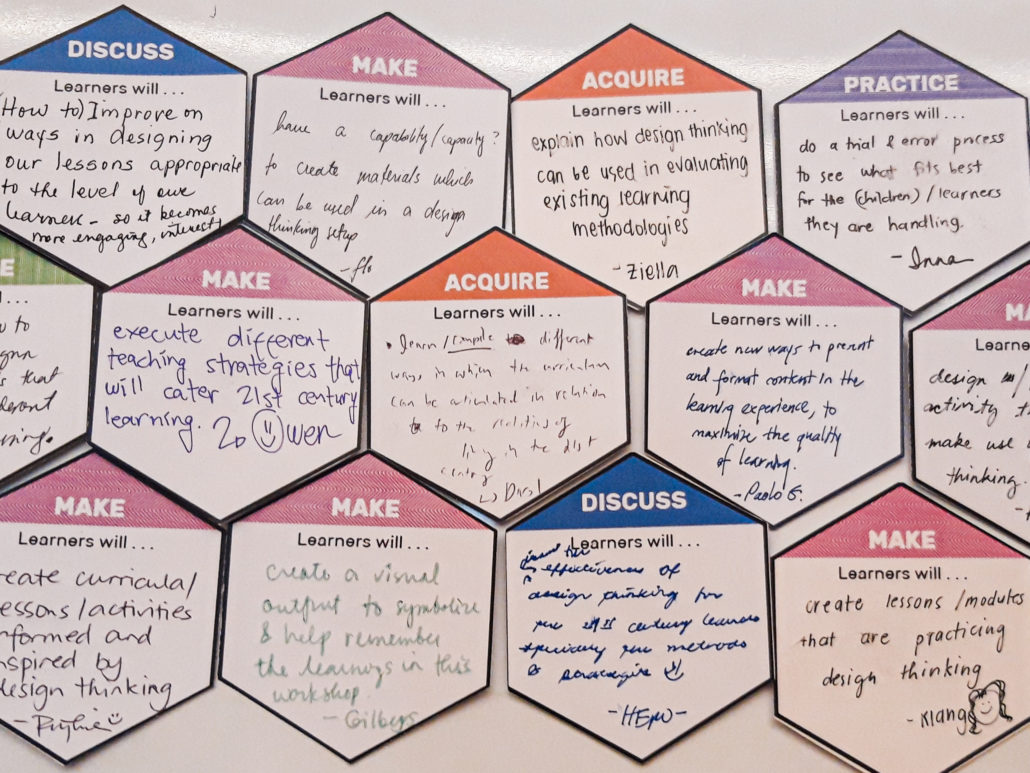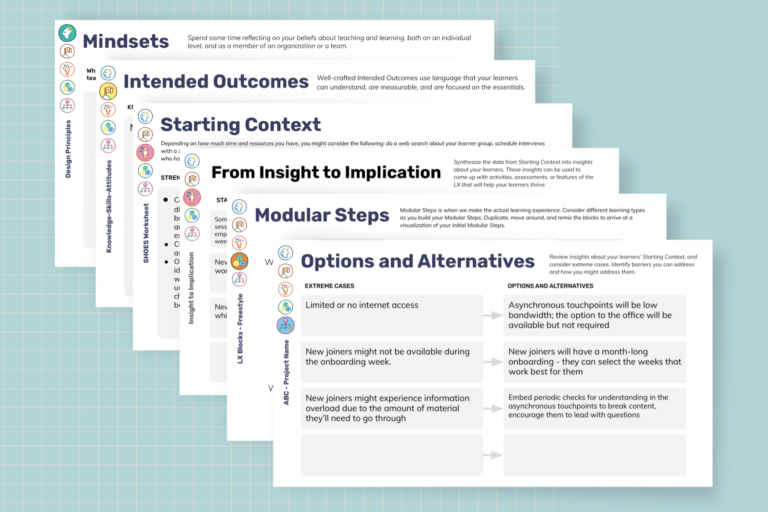How might we prototype learning experiences? This is something that we were constantly thinking about in 2018, when we started working with teachers to use design thinking as a way to design classroom activities, lessons, and even curricula. To answer this challenge, we looked deeper into our own process of designing workshops:
We would work individually first, writing down as many activity ideas as we could on metacards or even recycled pieces of card. There were only two rules to our individual work – we needed to have a time limit, and we needed to write one idea per card.
When the time ran out, it was time to put our ideas together. We would look at all our cards, then select which ones would go into the workshop plan. Using one activity per card made it easy to add activities, take some out, and rearrange the sequence for better flow.
We realized that this was actually our way of prototyping a learning experience! The LX Blocks are inspired by our early processes and the 6 Learning Types identified by Dr. Diana Laurillard in her book, Teaching as a Design Science. She theorizes that there are 6 types of interactions that can happen in all learning experiences:
 ACQUIRE
ACQUIRE
The most common learning type in formal education. When learners read a book, listen to lectures, or watch videos, they learn through acquisition.
Keywords: read, watch, listen
 INQUIRE
INQUIRE
When learners are asked to find the answer to a question through research, interviews, or data gathering, they learn through inquiry. In acquisition, learners are asked to read a book. In inquiry, the learners read a book to find answers to questions. This makes inquiry a more active learning process than acquisition.
Keywords: investigate, compare, assess, analyze, collect, search, evaluate
 DISCUSS
DISCUSS
When learners exchange questions or share their ideas with other people, such as teachers or fellow learners, they’re learning through discussion. This learning type requires the use of skills including listening and responding, which makes discussion an active and social process.
Keywords: exchange, debate, deliberate, talk through, comment
 PRACTICE
PRACTICE
When learners are given a task goal and receive feedback after each attempt, they are learning through practice. Feedback is the essential component of this learning type; they learn from the experience of taking action and hearing what went well, or how they can improve.
Keywords: try out, experiment, role-play, explore
 MAKE
MAKE
When learners are individually asked to make something for teachers to evaluate, like a project or a performance, they are learning through production.
Keywords: articulate, describe, design, write, report, perform, produce
 COLLABORATE
COLLABORATE
When learners work together to create a single, shared output, they’re learning through collaboration. This involves negotiating ideas until they can agree on a way forward through a shared output.
Discussions can simply be for exchanging ideas without a need to agree but learning through collaboration requires the learners to agree by creating a single product.
Keywords: build together, cooperate, combine

After a series of prototyping sessions, we settled on hexagons that can be put together like puzzle pieces. We complete the phrase “Learners will…” to keep our experiences learner-centered.
We use the LX Blocks in the Modular Steps phase of LX Design. Working with smaller units of learning makes it easier to –
- Design a learning experience with a team. Start by working individually, writing your ideas down on the blocks. When the time is up, take a step back and look at all the activities that you were able to come up with. Use your Mindset, Intended Outcomes, and Starting Context to decide which activities would make a well-designed learning experience and how to arrange them.
- Get feedback on our learning experience. When we started introducing LX Design to teachers, it was challenging to give and receive feedback because teachers can use different lesson plan formats depending on what their schools recommend. Using the 6 Learning Types to frame our LX gives us a shared language, making it easier to show each other what we mean.
- Redesign our learning experience. Working with blocks makes it easier to redesign your learning experience because we don’t have to scrap the entire thing – move blocks around or replace one with another and you’re done!
Try it out for yourself! Download the LX Blocks at design.habieducationlab.org where you can find more free resources on LX Design.


